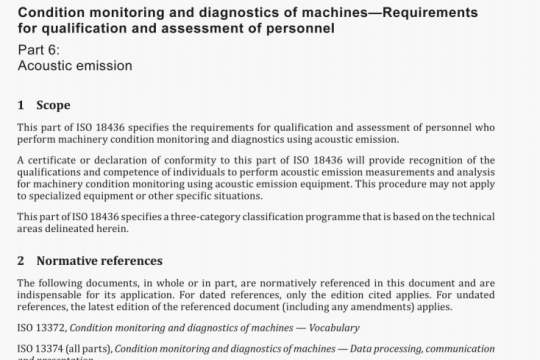ISO 5660-1:2015 pdf free
ISO 5660-1:2015 pdf free.Reaction-to-fire tests一Heat release, smoke production and mass loss rate
This part of ISO 5660 specifies a method for assessing the heat release rate and dynamic smoke production rate of specimens exposed in the horizontal orientation to controlled levels of irradiance with an external igniter. The heat release rate is determined by measurement of the oxygen consumption derived from the oxygen concentration and the flow rate in the combustion product stream. The time to ignition (sustained flaming) is also measured in this test.
The dynamic smoke production rate is calculated from measurement of the attenuation of a laser light beam by the combustion product stream. Smoke obscuration is recorded for the entire test, regardless of whether the specimen is flaming or not.
The test method is based on the observation that, generally, the net heat of combustion is proportional to the amount of oxygen required for combustion. The relationship is that approximately 13,1 x 103 kJ of heat are released per kilogram of oxygen consumed. Specimens in the test are burned under ambient air conditions, while being subjected to a predetermined external irradiance within the range of 0 kW m-2 to 75 kW m-2 and measurements are made of oxygen concentrations and exhaust gas flow rates.
This test method is used to assess the contribution that the product under test can make to the rate of evolution of heat during its involvement in fire. These properties are determined on small representative specimens.
The principle of the smoke measurement is based on the observation that, generally, the intensity of light that is transmitted through a volume of combustion products is an exponentially decreasing function of distance. This is commonly referred to as Bouguer’s law. Specimens in the test are burned in ambient air conditions, while being subjected to a predetermined external irradiance within the range 0 kW m-2 to 75 kW m-2 and measurements are made of smoke obscuration, exhaust gas flow rate, and mass loss rate of the specimen. Smoke obscuration is measured as the fraction of laser light intensity that is transmitted through the smoke in the exhaust duct. This fraction is used to calculate the extinction coefficient according to Bouguer’s law. The test results are reported in terms of smoke production and smoke production rate-both normalized to exposed specimen surface area. Smoke production rate is calculated as the product of the extinction coefficient and the volumetric flow rate of the smoke in the exhaust duct. Smoke production is calculated by numerical integration of the smoke production rate over the time interval being considered. The variables reported are normalized to area because smoke production is proportional to area.ISO 5660-1 pdf free.




